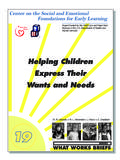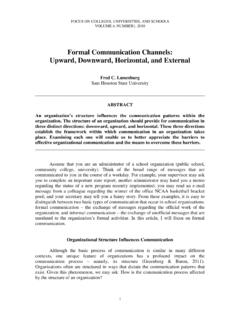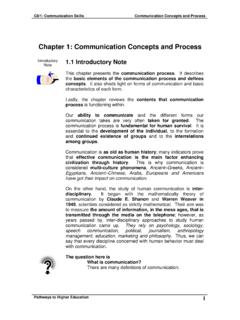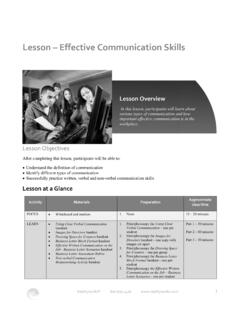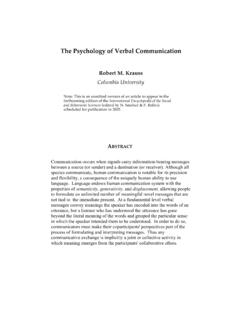Transcription of NONVERBAL BEHAVIOR AND NONVERBAL COMMUNICATION
1 NONVERBAL BEHAVIOR AND NONVERBAL COMMUNICATION :WHAT DO CONVERSATIONAL HAND GESTURES TELL US?ROBERT M. KRAUSS, YIHSIU CHEN, AND PURNIMA CHAWLAC olumbia UniversityThis is a pre-editing version of a chapter that appeared in M. Zanna(Ed.), Advances in experimental social psychology (pp. 389-450). SanDiego, CA: Academic 2 NONVERBAL BEHAVIOR AND NONVERBAL COMMUNICATION :WHAT DO CONVERSATIONAL HAND GESTURES TELL US?ROBERT M. KRAUSS, YIHSIU CHEN, AND PURNIMA CHAWLAC olumbia University1. THE SOCIAL PSYCHOLOGICAL STUDY OF NONVERBAL NONVERBAL BEHAVIOR as NONVERBAL communicationMuch of what social psychologists think about NONVERBAL behaviorderives from a proposal made more than a century ago by Charles Darwin.
2 InThe expression of the emotions in man and animals (Darwin,1872), he posed thequestion: Why do our facial expressions of emotions take the particular formsthey do? Why do we wrinkle our nose when we are disgusted, bare our teethand narrow our eyes when enraged, and stare wide-eyed when we aretransfixed by fear? Darwin's answer was that we do these things primarilybecause they are vestiges of serviceable associated habits behaviors that earlierin our evolutionary history had specific and direct functions. For a species thatattacked by biting, baring the teeth was a necessary prelude to an assault;wrinkling the nose reduced the inhalation of foul odors; and so if facial expressions reflect formerly functional behaviors, why havethey persisted when they no longer serve their original purposes?
3 Why dopeople bare their teeth when they are angry, despite the fact that biting is notpart of their aggressive repertoire? Why do they wrinkle their noses when theirdisgust is engendered by an odorless picture? According to Darwin's intellectualheirs, the behavioral ethologists ( , Hinde, 1972; Tinbergen, 1952), humans dothese things because over the course of their evolutionary history suchbehaviors have acquired communicative value: they provide others withexternal evidence of an individual's internal state. The utility of such informationgenerated evolutionary pressure to select sign behaviors, thereby schematizingthem and, in Tinbergen's phrase, "emancipating them" from their originalbiological Noncommunicative functions of NONVERBAL behaviorsSo pervasive has been social psychologists' preoccupation with thecommunicative or expressive aspects of NONVERBAL behaviors that the termsnonverbal BEHAVIOR and NONVERBAL COMMUNICATION have tended to be used 1 See Fridlund (1991)
4 For a discussion of the ethological Recently, however, it has been suggested that thiscommunicative focus has led social psychologists to overlook other functionssuch behaviors serve. For example, Zajonc contends that psychologists havebeen too quick to accept the idea that facial expression are primarily expressivebehaviors. According to his "vascular theory of emotional efference" (Zajonc,1985; Zajonc, Murphy, & Inglehart, 1989) , the actions of the facial musculaturethat produce facial expressions of emotions serve to restrict venous flow,thereby impeding or facilitating the cooling of cerebral blood as it enters thebrain.
5 The resulting variations in cerebral temperature, Zajonc hypothesizes,promote or inhibit the release of emotion-linked neurotransmitters, which, inturn, affect subjective emotional experience. From this perspective, facialexpressions do convey information about the individual's emotional state, butthey do so as an indirect consequence of their primary, analogous argument has been made for the role of gaze direction insocial interaction. As people speak, their gaze periodically fluctuates toward andaway from their conversational partner. Some investigators have interpretedgaze directed at a conversational partner as an expression of intimacy orcloseness (cf.)
6 , Argyle & Cook, 1976; Exline, 1972; Exline, Gray, & Schuette, 1985;Russo, 1975) . However, Butterworth (1978) argues that gaze direction isaffected by two complex tasks speakers must manage concurrently: planningspeech, and monitoring the listener for visible indications of comprehension,confusion, agreement, interest, etc. (Brunner, 1979; Duncan, Brunner, & Fiske,1979) . When the cognitive demands of speech planning are great, Butterworthargues, speakers avert gaze to reduce visual information input, and, when thosedemands moderate, they redirect their gaze toward the listener, especially atplaces where feedback would be useful.
7 Studies of the points in the speechstream at which changes in gaze direction occur, and of the effects of restrictingchanges in gaze direction (Beattie, 1978; Beattie, 1981; Cegala, Alexander, &Sokuvitz, 1979) , tend to support Butterworth's Interpersonal and intrapersonal functions of NONVERBAL behaviorsOf course, NONVERBAL behaviors can serve multiple functions. Facialexpression may play a role in affective experience by modulating vascularblood flow as Zajonc has proposed or through facial feedback as has beensuggested by Tomkins and others (Tomkins & McCarter, 1964) and at the sametime convey information about the expressor's emotional state.
8 Suchcommunicative effects could involve two rather different mechanisms. In thefirst place, many NONVERBAL behaviors are to some extent under the individual'scontrol, and can be produced voluntarily. For example, although a smile may bea normal accompaniment of an affectively positive internal state, it can at least tosome degree be produced at will. Social norms, called "display rules," dictate thatone exhibit at least a moderately pleased expression on certain social occasions. 2 For example, the recent book edited by Feldman and Rim (1991) reviewing researchin this ara is titled Fundamentals of NONVERBAL BEHAVIOR , despite the fact that all of thenonverbal behaviors are discussed in terms of the role they play in COMMUNICATION (see Krauss(1993).)
9 Page 4 Kraut (1979) found that the attention of others greatly potentiates smiling insituations that can be expected to induce a positive internal state. In the secondplace, NONVERBAL behaviors that serve noncommunicative functions can provideinformation about the noncommunicative functions they serve. For example, ifButterworth is correct about the reason speakers avert gaze, an excessiveamount of gaze aversion may lead a listener to infer that the speaker is havingdifficulty formulating the message. Conversely, the failure to avert gaze atcertain junctures, combined with speech that is overly fluent, may lead anobserver to infer that the utterance is not in this fashion, we can distinguish between interpersonal andintrapersonal functions that NONVERBAL behaviors serve.
10 The interpersonalfunctions involve information such behaviors convey to others, regardless ofwhether they are employed intentionally (like the facial emblem) or serve as thebasis of an inference the listener makes about the speaker (like dysfluency). Theintrapersonal functions involve noncommunicative purposes the behaviorsserve. The premise of this chapter is that the primary function of conversationalhand gestures (unplanned, articulate hand movements that accompanyspontaneous speech) is not communicative, but rather to aid in the formulationof speech.










